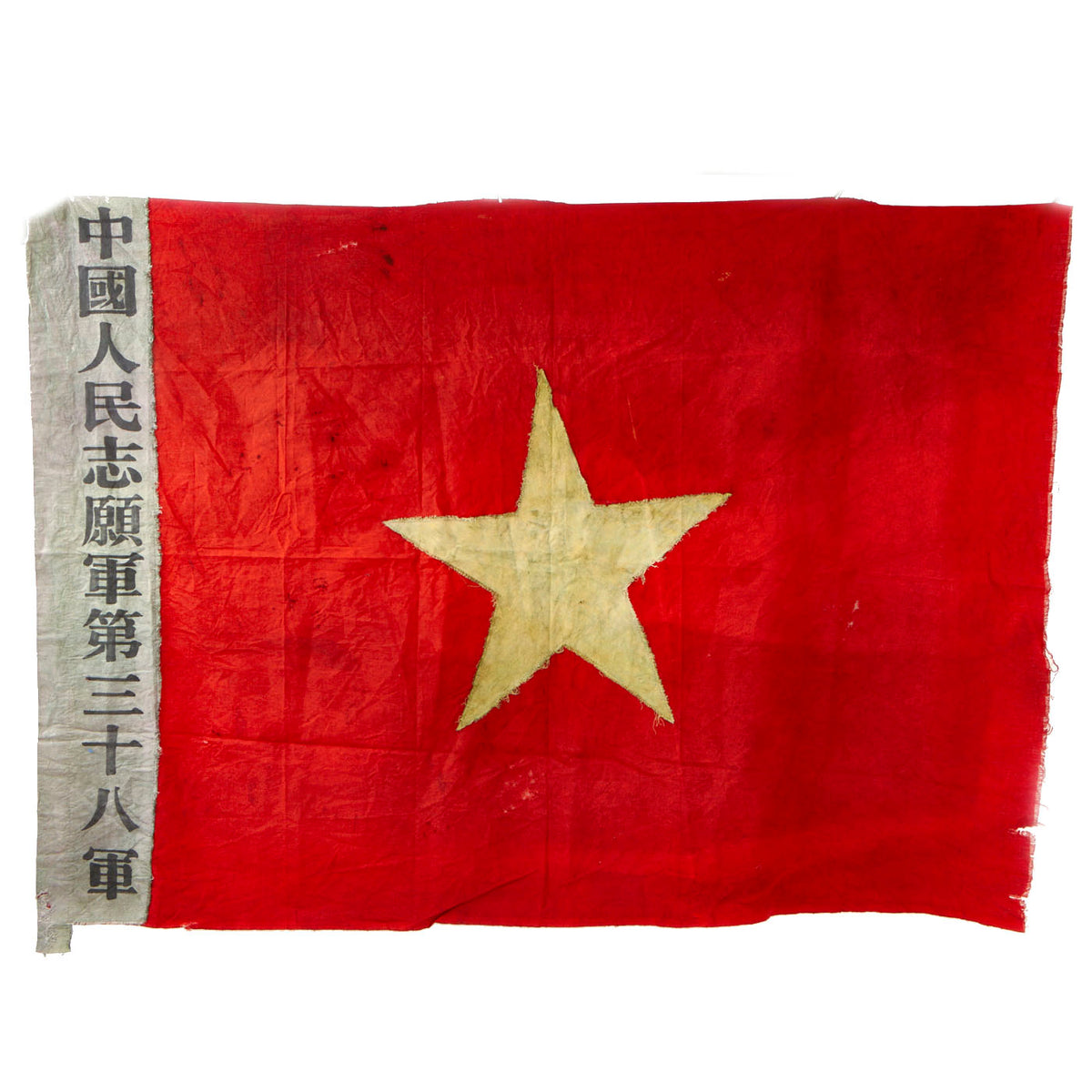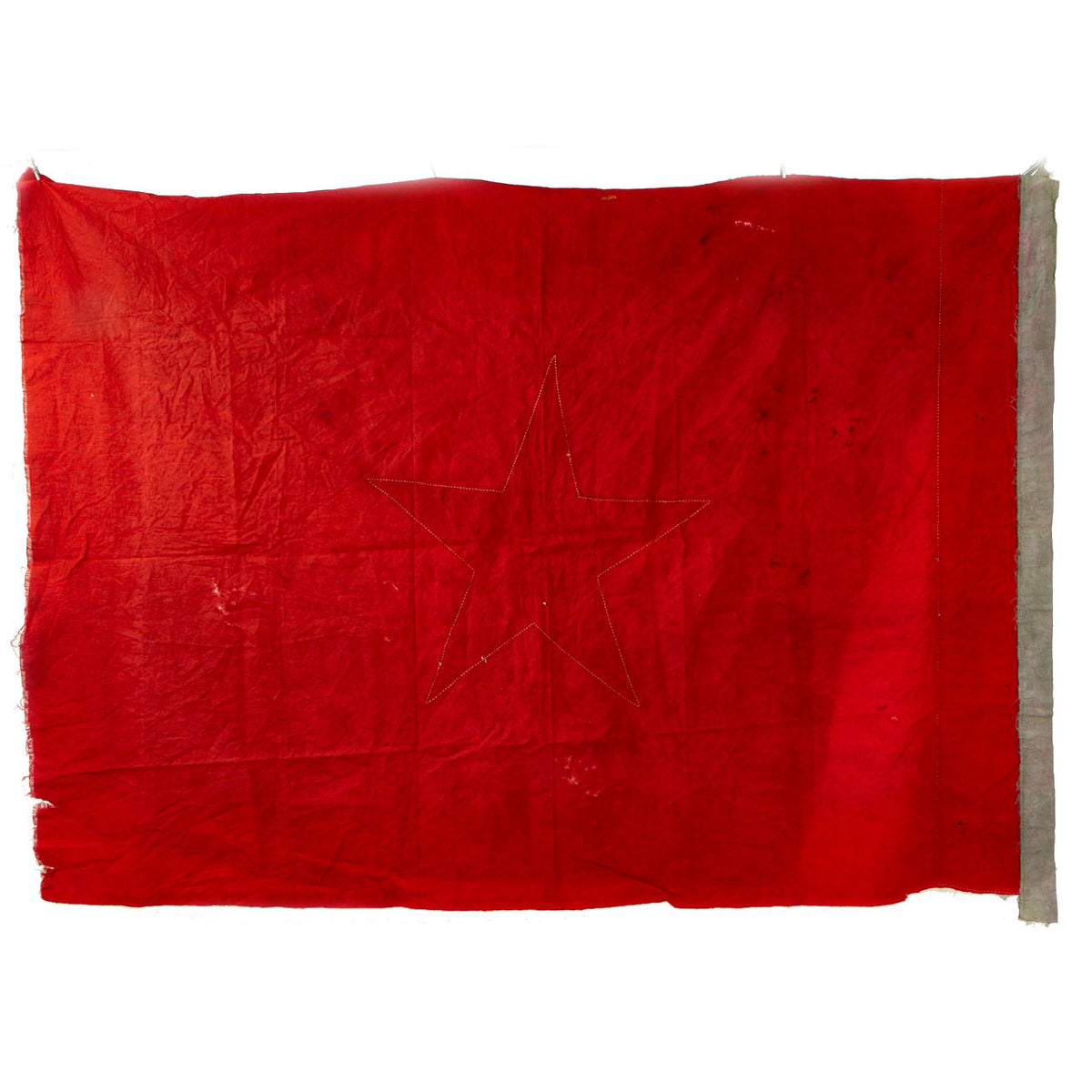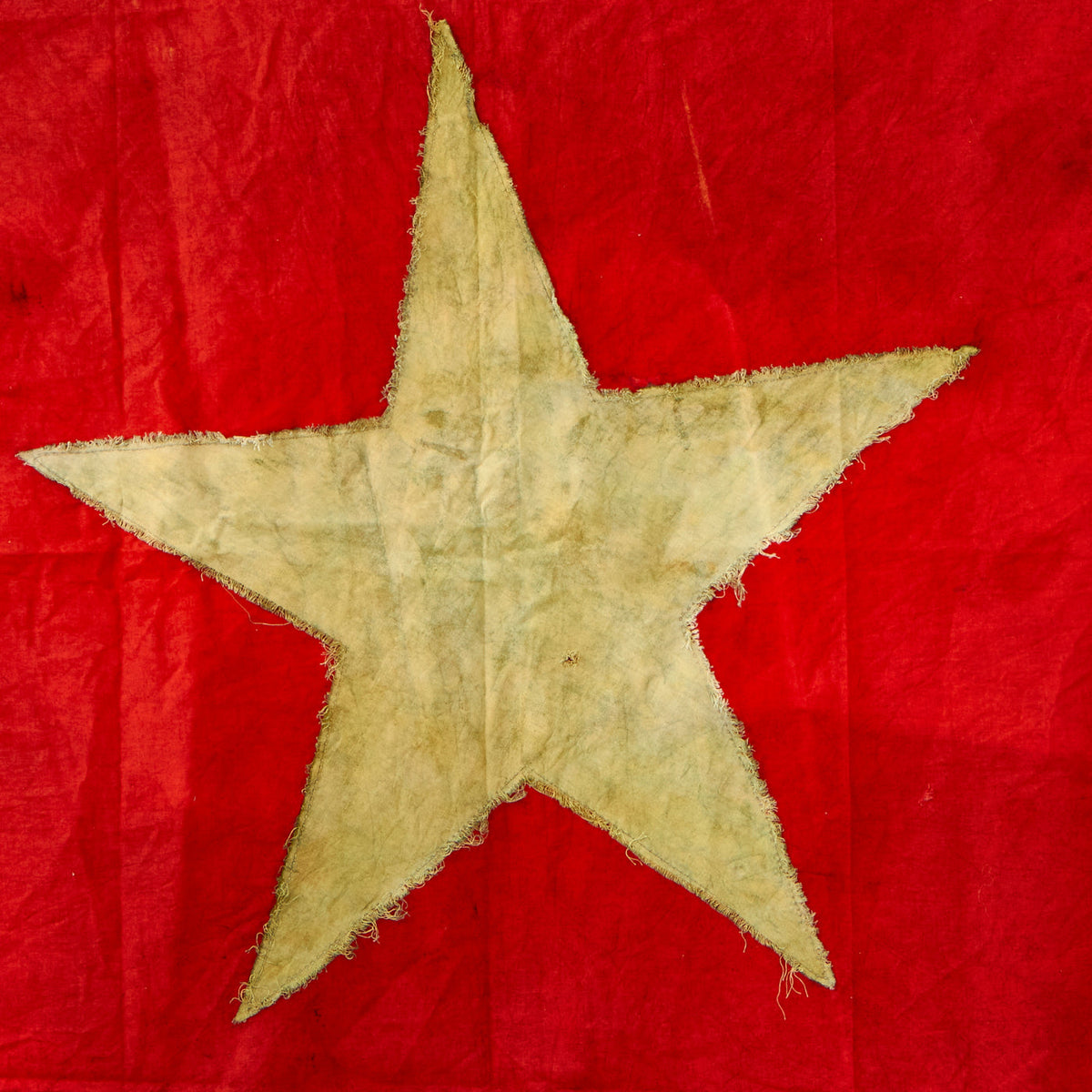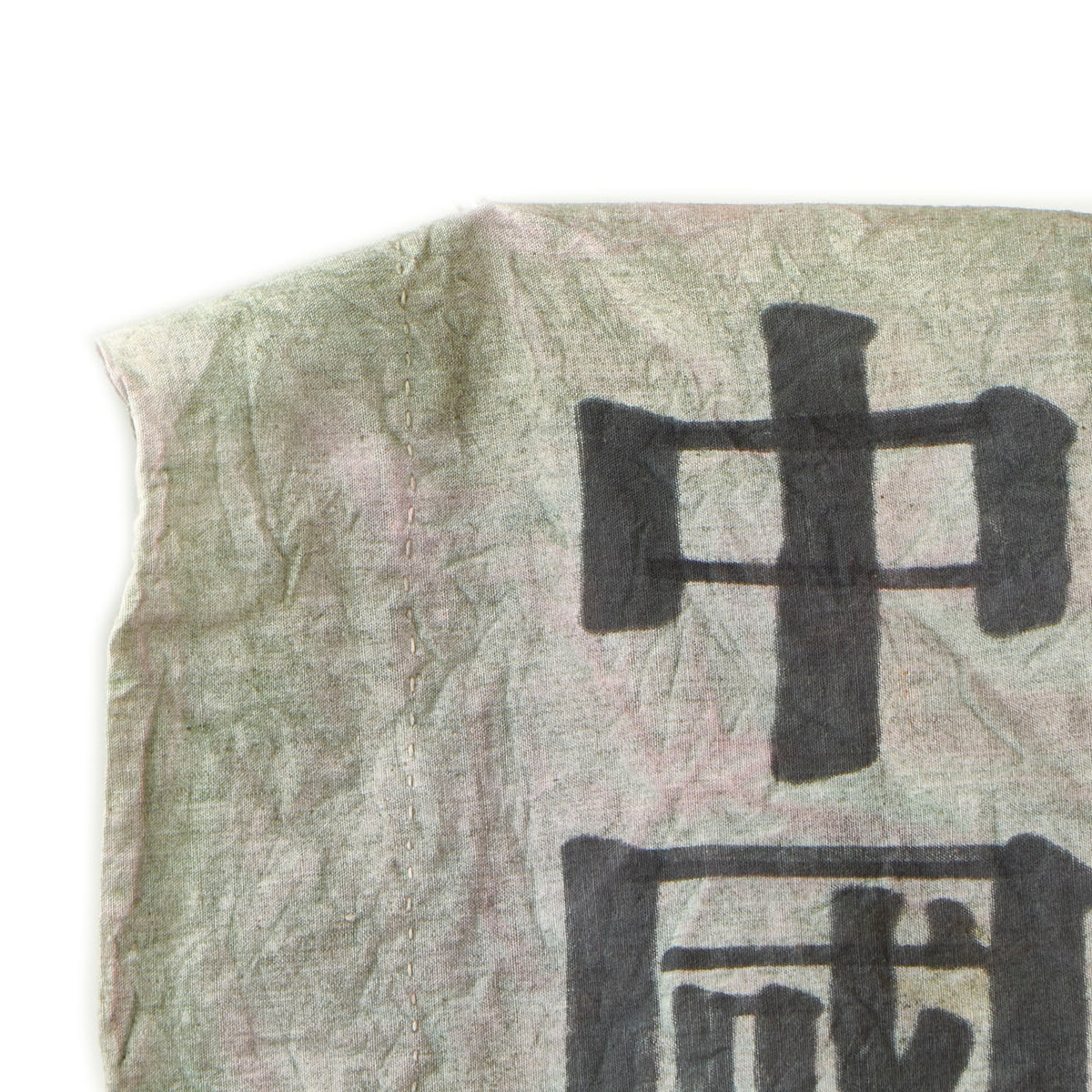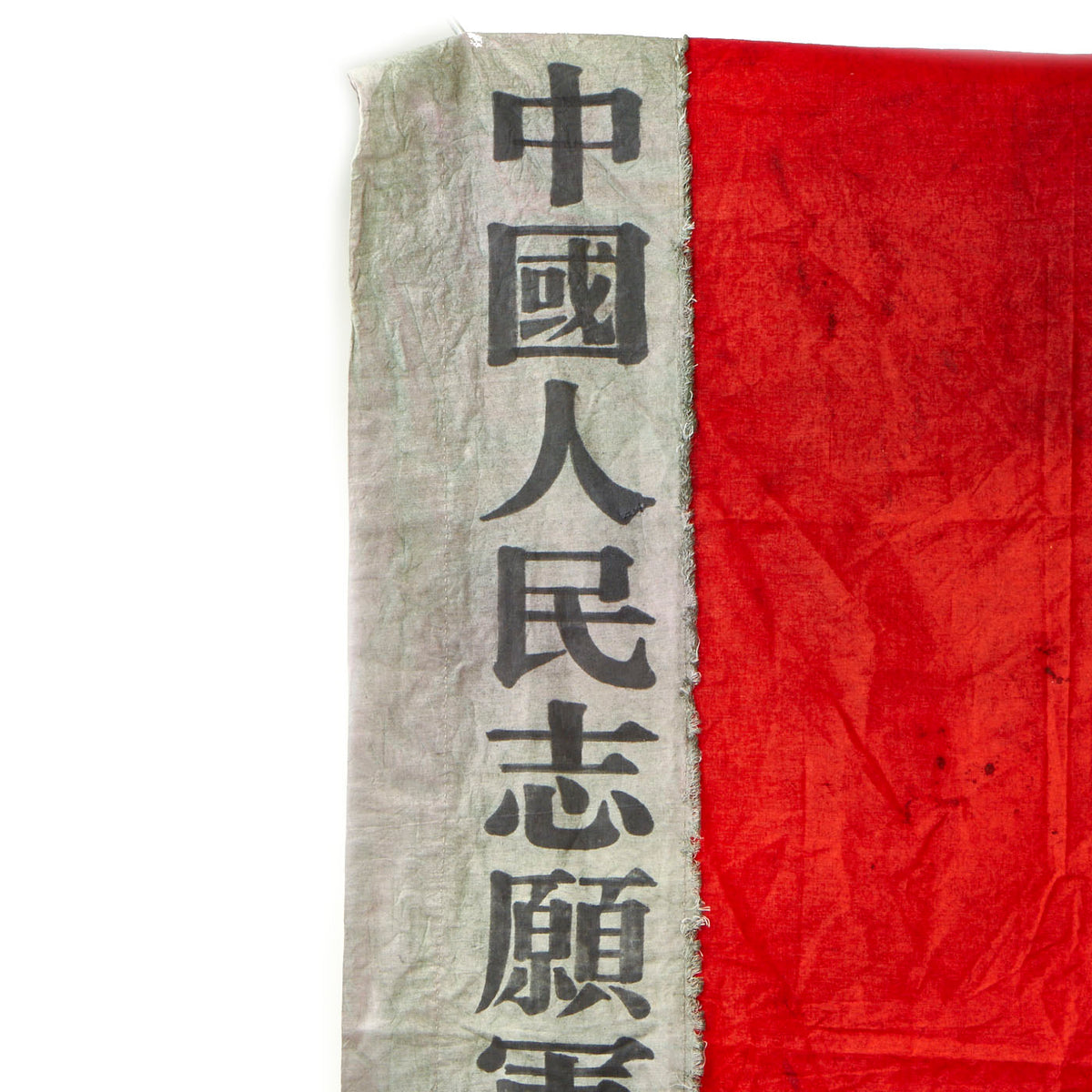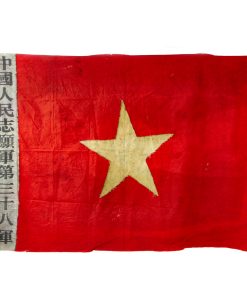Original China Korean War Era Chinese People’s Volunteer Army 38th Corps Flag – 44” x 61” Original Items
$ 1.495,00 $ 373,75
Original Item: Only One Available. After the People’s Republic of China entered the Korean War in October 1950 by designating the People’s Liberation Army (PLA) North East Frontier Force as the People’s Volunteer Army (PVA), the PVA spent the next two years and nine months in combat operations and five years and three months in garrison duties. Its last elements did not leave Korea until as late as 1958.
During this period, China paid a huge price for its involvement in the Korean War. According to Chinese archives, about 73 percent of Chinese infantry forces, 67 percent of Chinese artillery forces, 100 percent of Chinese armored forces and 52 percent of Chinese air forces were deployed in Korea at one point or another, alongside 600,000 civilian laborers – in total more than three million civilian and military personnel. Out of those forces, around 152,000 were killed, 383,500 were wounded, 450,000 were hospitalized, 21,300 were captured and 4,000 were missing. Of the captured 14,190 defected to Taiwan after the ceasefire. China had also consumed 5.6 million tons of war materiel, 399 aircraft and 12,916 vehicles for its war efforts. About a third of the Chinese government’s annual budget was spent on the military between 1950–53, totaling 10 billion RMB by the war’s end. All in all, the Korean War was the largest foreign war in Chinese military history, despite the fact that no declaration of war ever existed between China and United Nations forces.
For many years, historians found it difficult to provide an accurate order of battle for Chinese troops in Korea because most of the information could only be obtained from prisoner interrogations or captured documents. The constant Chinese troop movements and the reattachment of units between different commands further added to the confusion.
By the 1980s, however, a large number of primary documents, memoirs and scholarly works on Chinese involvement in the Korean War began to appear in China, enabling historians to make a more comprehensive and accurate assessment of Chinese military operations during the war.
As the term “Corps” does not technically exist in Chinese military, the term “Army” (军) technically means “Corps” in PLA nomenclature, while the term “Army Group” (集团军 or 兵团) means “Army”. For example, the US X Corps is always referred to as the “US 10th Army” (美第10军) among Chinese sources. For simplicities sake, we are going with the “38th Corps”.
This 44” x 61” 38th Corps flag is labeled on the hoist side with 中國人民志願軍第三十八軍, identifying this flag as being for “The 38th Corps of the Chinese People’s Volunteers”. The flag features an all red field with a white star in the center. As with most Chinese “Regimental’ or “Division” unit flags, the identifier is usually located on the left side of the flag and reads vertically on a white or light colored strip of cloth stitched on.
The overall condition is very nice but there is evident signs of being flown on the battlefield. There are some stains, fraying and holes present but these do not subtract from the beauty of this rather rare flag.
This is a wonderful example of a Chinese 38th Corps flag and it comes more than ready for further research and display!
The 38th, the 40th and the 42nd Corps (the finest of the Fourth Field Army) along with the 27th and the 39th Corps from South China were placed at Peng Dehuai’s disposal as part of the People’s Volunteer Army (Chinese People’s Volunteers (CPV) XIII Army Group, for the initial Chinese intervention in Korea.
In Battle of the Ch’ongch’on River 38th Corps and the 42nd Corps poured through the broken South Korean lines to Eighth Army’s east and threatening to envelop the entire force. The 38th corps overran ROK 7th Division on November 25–26, then Turkish Brigade on 26-29. Its 113rd division covered 72.5 kilometers within 14 hours and reached Samso-ri on November 28 7:00 to halt US 2nd Infantry Division from retreat. 38th Corps was ultimately successful in setting up the “Gauntlet” against the US 2nd Infantry Division at Kunu-ri, and for its performance it received the title “Ten thousand years Army” (万岁军). It’s estimated that Chinese People’s Volunteer Army inflicted 23,000 casualties[4] on UNC, among them, 7,485 killed or wounded and 3,616 captured (including 1,042 US soldiers) were inflicted by the 38th Corps. US Eighth Army estimated it suffered 11,000 casualties, excluding South Korean casualties.
In Third Battle of Seoul, the 38th Corps broke through defence organized by ROK 6th Division within 20 minutes on December 31, then defeated a regiment of US 24th Infantry Division on the southeast of Uijeongbu on January 3.
In the Fourth Phase Battle, the 38th Corps were deployed on the south bank of the Han River to defend against US 24th Infantry Division, US First Cavalry Division, British 27th Brigade and ROK 6th division. During 50 days fierce fight, the 38th Corps estimated that it inflicted more than 10,800 casualties on UNC, but the 38th Corps suffered 3,359 killed which accounts for some 50% of all the 38th Corps soldiers killed in Korean war.
The formation opposed the Turkish Brigade at the Battle of Wawon on November 27–29, 1950, and the U.S. 45th Infantry Division during the Battle of Old Baldy.
On October 6–15, 1952, the 38th Corps fought in the battle for Baengma-goji, a 395-meter hill near the Iron Triangle. During the course of the battle, the hill changed hands 24 times after repeated attacks and counterattacks for its possession. It was the most intense position-grasping battle for a small hill during the course of the Korean War. The 112th and 114th Divisions under the command of General Gang Ong-hwi were selected as the main force to capture Baengma-goji, and the 113th Division was to replenish the losses of the main force. The 38th Corps committed five regiments out of its total of nine regiments and sustained a total of 5,372 casualties (1,748 dead, 3062 wounded and 562 missing[4]), while the 9th Division of South Korea suffered a total of 3,422 casualties (505 dead, 2,562 injured and 391 missing), plus over 400 more casualties in the 1st Battalion of the 30th Regiment. The American Fifth Air Force made a total of 745 sorties and poured more than 2,700 bombs of various kinds, together with over 358 napalm bombs, onto the hill. Chinese forces rained no less than 55,000 shells during the nine-day battle period, and the South Korean forces fired over 185,000 bombs. The 38th Corps, after having been replaced by the 23rd Corps, had to withdraw to the rear.
In the Korean war 6,772 soldiers serving in the 38th corps were killed, among them 599 were killed in First Phase Battle, 415 were killed in Second Phase Battle (Ch’ongch’on River sector), 247 were killed in Third Phase Battle (Seoul sector), 3,359 were killed in Fourth Phase Battle and 1,748 were killed in Battle of the White Horse Hill.
Fast Shipping with Professional Packaging
Thanks to our longstanding association with UPS FedEx DHL, and other major international carriers, we are able to provide a range of shipping options. Our warehouse staff is expertly trained and will wrap your products according to our exact and precise specifications. Prior to shipping, your goods will be thoroughly examined and securely secured. We ship to thousands clients each day across multiple countries. This shows how we're dedicated to be the largest retailer on the internet. Warehouses and distribution centres can be located throughout Europe as well as the USA.
Note: Orders with more than one item will be assigned a processing date depending on the item.
Before shipping before shipping, we'll conduct a thorough inspection of the items you have ordered. Today, the majority of orders will be delivered within 48 hours. The delivery time will be between 3-7 days.
Returns
The stock is dynamic and we cannot completely manage it because multiple stakeholders are involved, including our factory and warehouse. So the actual stock may alter at any time. It's possible that you may not receive your order once the order has been made.
Our policy is valid for a period of 30 days. If you don't receive the product within 30 days, we are not able to issue a refund or an exchange.
You can only return an item if it is unused and in the same state as the day you received it. You must have the item in its original packaging.
Related products
Uncategorized
Uncategorized
Uncategorized
Uncategorized
Australian WWII Owen MK1 Machine Carbine SMG Custom Fabricated Replica with Sling Original Items
Uncategorized
Uncategorized
Uncategorized
Uncategorized
Band of Brothers ORIGINAL GERMAN WWII Le. F.H. 18 10.5cm ARTILLERY PIECE Original Items
Uncategorized
Uncategorized
Armored Burgonet Helmet & Polearm from Scottish Castle Leith Hall Circa 1700 Original Items
Uncategorized
Uncategorized
Uncategorized
Uncategorized
Uncategorized
Uncategorized
Uncategorized
